|
|
|
Sort Order |
|
|
|
Items / Page
|
|
|
|
|
|
|
| Srl | Item |
| 1 |
ID:
139052
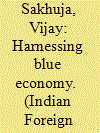

|
|
|
|
|
| Summary/Abstract |
Blue Economy is a relatively new concept and is resonating among a number of countries across the globe. It involves a number of interdependent sectors, which harness the wealth of the seas for economic growth through sustainable development to advance growth and enhance human security. Blue economy is slowly finding reference in the national maritime thinking among South Asian Countries and the national agendas acknowledge the potential of the seas for economic development. However, these countries face a number of technological and financial constraints to pursue the Blue Economy; but a pan-South Asian approach can help that dream come true.
|
|
|
|
|
|
|
|
|
|
|
|
|
|
|
|
| 2 |
ID:
139055


|
|
|
|
|
| Summary/Abstract |
[W]hether India can have an overall comparative advantage in trade in the region as a whole is questionable. However, what could be focused upon are the benefits, which India could gain from the regional integration as the ASEAN and India become significant players in shaping the regional trading architecture. How these agreements have an impact on the Indian economy in the near future would largely be dependent on India itself and its preparations to be able to optimally make use of the opportunities presented to it. India probably needs to be more cautious before deciding to further liberalise the current AIFTA, i.e. including more products in the Normal Track list, which seems to be the eventual aim. Domestic implications of such measures need to be taken into account rather than merely following the decided time frames on liberalisation of various products.
|
|
|
|
|
|
|
|
|
|
|
|
|
|
|
|
| 3 |
ID:
139049
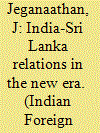

|
|
|
|
|
| Summary/Abstract |
There is no doubt that the Modi government is much more assertive and very articulate of its regional interests as compared to the previous government. It has clearly indicated that India would play a leadership role in South Asia, with less interference but more involvement in the development sectors in its neighbouring countries. It wants to make its footprint stronger in the economic development of neighbouring countries. This is not necessarily only to contain China’s aggressive inroads; rather, it is to expand both its shrinking markets as well as its cultural identity. The ‘SAARC Yatra’ by the new Foreign Secretary is an innovative strategy adopted by the MEA to strengthen India’s role in the neighbourhood. With its new leaderships, both India and Sri Lanka should take a fresh look at each other; and it is high time they take the bilateral relationship between the two countries to the next phase.
|
|
|
|
|
|
|
|
|
|
|
|
|
|
|
|
| 4 |
ID:
139053
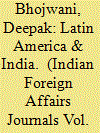

|
|
|
|
|
| Summary/Abstract |
The article outlines the relationship between India and that distant region, with which India has enjoyed a cordial relationship that has nevertheless not been as active as this emerging power has developed with any other region. This is despite the complementarity that is evident in the resource endowments of Latin America, India’s manufacturing prowess and its enormous market, mutually beneficial technological capabilities, etc. The article points out the areas of potential and urges a greater and more focussed activism on the part of the official and business establishments on both sides. The benevolent political environment, and the recent Latin American interest in India should galvanise the upward spiral of trade, investment, tourism and cultural exchanges.
|
|
|
|
|
|
|
|
|
|
|
|
|
|
|
|
| 5 |
ID:
139048
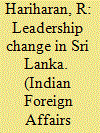

|
|
|
|
|
| Summary/Abstract |
At the strategic security level, apart from Sri Lanka’s bid to renew relations with India, China’s concerns with the Sirisena government relate to its ambitious power projection in South Asia and the Indian Ocean Region (IOR). Sri Lanka has emerged as a key strategic pivot astride the Indian Ocean to further China’s 21st Century Maritime Silk Route (MSR). Sri Lanka has already announced its support to the initiative. China has recently announced an outlay of US$ 40 billion for the MSR. With this huge investment, and those already made in port and road infrastructure projects in Sri Lanka and Pakistan, China simply cannot afford any obstruction to the completion of MSR, which would increase its strategic reach in keeping with its global ambitions. China has tried to use its existing discounted but firm relationship with Sri Lanka by turning President Sirisena’s desire to rebalance Sri Lanka’s relations with India as an opportunity for evolving a triangular relationship with India and Sri Lanka. This would help China further its strategic objectives in IOR and South Asia, as well as bring in India to join the MSR and turn it into a successful project.
|
|
|
|
|
|
|
|
|
|
|
|
|
|
|
|
| 6 |
ID:
139054


|
|
|
|
|
| Summary/Abstract |
“Look East” is a passive adumbration. “Act East” incorporates greater action and dynamism. This has been brought about in the recent statements of Prime Minister Narendra Modi. External Affairs Minister Sushma Swaraj has expanded on this thought. When India looks at the region to its east, barring few fulminations, this area is relatively peaceful and cohesive for its engagement. This does not distract from India’s extensive contacts with the countries in the Gulf, Europe and elsewhere where it continues to be engaged economically, socially and from a geostrategic point of view.
|
|
|
|
|
|
|
|
|
|
|
|
|
|
|
|
| 7 |
ID:
139051
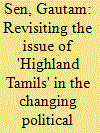

|
|
|
|
|
| Summary/Abstract |
In this context, there is an apparent need for a new appraisal of the status, both economic and political, of the Hill Country or Highland Tamils of Indian origin in Sri Lanka. This community is nearly 1.48 million in number, and constituted approximately 11.61 per cent of the total Sri Lankan population as per the official Census data of 1971. They continue to form an important part of Sri Lankan citizenry even though their strength may have marginally declined in the years following 1971, especially after some spells of repatriation to India consequent on the Amendment of the Shastri-Sirimavo Accord of 1964, and after the Indira-Sirimavo Agreement of 1974. The Highland Tamils (also known as Malaiha Tamils) are quite distinct from the Tamils of Northern and Eastern Sri Lanka, and have led a practically disenfranchised existence for quite some time since the country’s independence in 1948.
|
|
|
|
|
|
|
|
|
|
|
|
|
|
|
|
| 8 |
ID:
139050
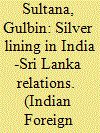

|
|
|
|
|
| Summary/Abstract |
With the election of Maithripala Sirisena as President of Sri Lanka, and the formation of the National Unity Government, it is expected that India’s southern neighbour will have a more democratic polity as compared to the earlier one. In addition, there is also a general popular expectation that, under the new government, there would be a greater balance in dealing with developmental issues in various constituent provinces of the island nation. There is also a general hope that there will be a thawing in the almost frozen India-Sri Lanka relationship. The Sirisena government is also likely to have a positive approach towards India, already indicated by the few initiatives that his government has taken. It will try to mend relations with India not necessarily by jettisoning its relations with China. A deft political calculation will be required by the Sirisena government on the issue of the implementation of the 13th Amendment, as it has the potential to cause a significant political loss by an upset Sinhala majority. The best way forward for Sri Lanka would be in following a middle path in its foreign policy, keeping in mind strategic concerns of an important neighbour like India.
|
|
|
|
|
|
|
|
|
|
|
|
|
|
|
|
| 9 |
ID:
139047
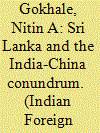

|
|
|
|
|
| Summary/Abstract |
President Sirisena’s major task will be to re-calibrate Sri Lanka’s relations with India in the wake of a decade long period of China-friendly policies pursued by his predecessor, President Rajapaksa. While India’s strategic interests in Sri Lanka are vital, it also has old cultural and religious ties with the Sri Lankan society going back centuries. A relatively new entrant to the island, China has made large, strategic and commercial investments in Sri Lanka over the last decade, thanks to the Rajapaksas who tried to play China against India. That Sirisena, backed by former President Chandrika Kumaratunga and Prime Minister Ranil Wickramasinghe, is not exactly well-disposed towards Beijing, is well known However, China cannot easily be shrugged off. Consider this: between 2005 and 2012, China provided US$ 4.761 billion as assistance to Sri Lanka. Of this, only two per cent is an outright grant while the remaining 98 per cent is in the form of soft loans. By contrast, a third of India’s US$ 1.6 billion dollars assistance programme to the island comprises of outright grants.
|
|
|
|
|
|
|
|
|
|
|
|
|
|
|
|
| 10 |
ID:
139046
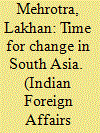

|
|
|
|
|
| Summary/Abstract |
It is time for change in South Asia. First, Narendra Modi came to the helm of affairs in India last year, riding on the wave of change. That is now followed by Maithripala Sirisena assuming Presidency in Sri Lanka after defeating his predecessor, Mahinda Rajapaksa in a closely contested election on January 8 this year. In both cases, the electorate catapulted into power men who promised change in all earnestness. In their election campaigns, both leaders pledged to sound the death knell of corruption, nepotism, non-governance, and concentration of power in the hands of a few in their countries. The electrically charged environment in both nations also resonated with assertions of good neighbourly goals. Although only time will tell the true extent of any real change, with the leadership change, a new hope dawns for improvements in India-Sri Lanka relations.
|
|
|
|
|
|
|
|
|
|
|
|
|
|
|
|
|
|
|
|
|